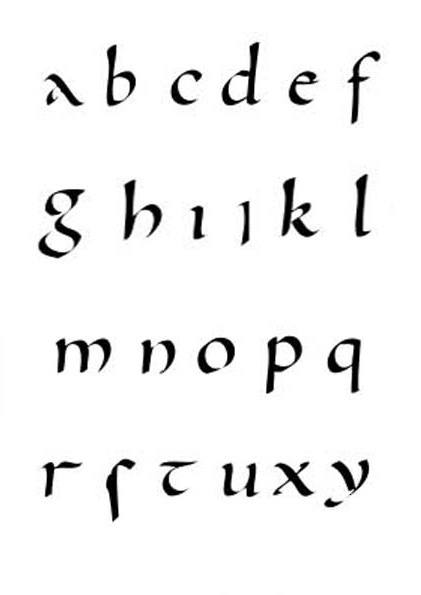
Carolingian minuscule
Carolingian minuscule or Caroline minuscule is a script which developed as a calligraphic standard in the medieval European period so that the Latin alphabet of Jerome's Vulgate Bible could be easily recognized by the literate class from one region to another. It is thought to have originated before 778 CE at the scriptorium of the Benedictine monks of Corbie Abbey, about 150 kilometres (95 miles) north of Paris, and then developed by Alcuin of York for wide use in the Carolingian Renaissance.[1][2][3] Alcuin himself still wrote in a script which was a precursor to the Carolingian minuscule, which slowly developed over three centuries.[4][5] He was most likely responsible for copying and preserving the manuscripts[6] and upkeep of the script.[7] It was used in the Holy Roman Empire between approximately 800 and 1200. Codices, pagan and Christian texts, and educational material were written in Carolingian minuscule.
After blackletter developed out of it, the Carolingian minuscule became obsolete, until the 14th century Italian Renaissance, when the humanist minuscule script was also developed from it. By this latter line the Carolingian minuscule is a direct ancestor of most modern-day Latin letter scripts and typefaces.
Spread[edit]
The new script spread through Western Europe most widely where Carolingian influence was strongest. In luxuriously produced lectionaries that now began to be produced for princely patronage of abbots and bishops, legibility was essential. It reached far afield: the 10th century Freising manuscripts, which contain the oldest Slovene language, the first Roman-script record of any Slavic language, are written in Carolingian minuscule. In Switzerland, Carolingian was used in the Rhaetian and Alemannic minuscule types. Manuscripts written in Rhaetian minuscule tend to have slender letters, resembling Insular script, with the letters ⟨a⟩ and ⟨t⟩, and ligatures such as ⟨ri⟩, showing similar to Visigothic and Beneventan. Alemannic minuscule, used for a short time in the early 9th century, is usually larger, broader, and very vertical in comparison to the slanting Rhaetian type. It was developed by the monk Wolfcoz I at the Abbey of Saint Gall.[10] In the Holy Roman Empire, Carolingian script flourished in Salzburg, Austria, as well as in Fulda, Mainz, and Würzburg, all of which were major centers of the script. German minuscule tends to be oval-shaped, very slender, and slanted to the right. It has uncial features as well, such as the ascender of the letter ⟨d⟩ slanting to the left, and vertical initial strokes of ⟨m⟩ and ⟨n⟩.
In northern Italy, the monastery at Bobbio used Carolingian minuscule beginning in the 9th century. Outside the sphere of influence of Charlemagne and his successors, however, the new legible hand was resisted by the Roman Curia; nevertheless the Romanesca type was developed in Rome after the 10th century. The script was not taken up in England and Ireland until ecclesiastic reforms in the middle of the 10th century; in Spain a traditionalist Visigothic hand survived; and in southern Italy a 'Beneventan minuscule' survived in the lands of the Lombard duchy of Benevento through the 13th century, although Romanesca eventually also appeared in southern Italy.
Role in cultural transmission[edit]
Scholars during the Carolingian Renaissance sought out and copied in the new legible standardized hand many Roman texts that had been wholly forgotten. Most of contemporary knowledge of classical literature derives from copies made in the scriptoria of Charlemagne. Over 7000 manuscripts written in Carolingian script survive from the 8th and 9th centuries alone.
Though the Carolingian minuscule was superseded by Gothic blackletter hands, in retrospect, it seemed so thoroughly 'classic' to the humanists of the early Renaissance that they took these old Carolingian manuscripts to be ancient Roman originals, and used them as bases for their Renaissance hand, the "humanist minuscule".[11] From there the script passed to the 15th- and 16th-century printers of books, such as Aldus Manutius of Venice. In this way it forms the basis of our modern lowercase typefaces. Indeed, 'Carolingian minuscule' is a style of typeface, which approximates this historical hand, eliminating the nuances of size of capitals, long descenders, and so on.